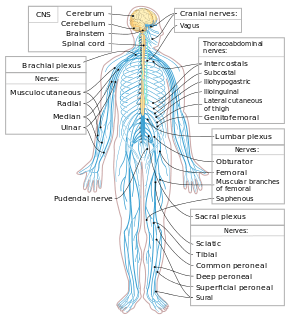Pressure point
| Pressure point (穴位) | |||||||||||||||||||||||||||
|
| |||||||||||||||||||||||||||
| Chinese name | |||||||||||||||||||||||||||
|---|---|---|---|---|---|---|---|---|---|---|---|---|---|---|---|---|---|---|---|---|---|---|---|---|---|---|---|
| Chinese | 穴位 | ||||||||||||||||||||||||||
| |||||||||||||||||||||||||||
| Japanese name | |||||||||||||||||||||||||||
| Kanji | 急所 | ||||||||||||||||||||||||||
| Kana | きゅうしょ | ||||||||||||||||||||||||||
| |||||||||||||||||||||||||||
A pressure point (Chinese: 穴位; Japanese: kyūsho 急所 "vital point, tender spot";[1] Sinhala: නිල/මර්ම ස්ථාන Nila/Marma Sthana (in Angampora); Telugu: మర్మ స్థానం Marma Sthanam; Malayalam: മര്മ്മം marmam; Tamil: வர்மம் varmam) derives from the meridian points in Traditional Chinese Medicine and Indian Ayurveda and Siddha medicine, and the field of martial arts, and refers to an area on the human body that may produce significant pain or other effects when manipulated in a specific manner.[2]
[3] The concept of pressure points spread through the South Indian martial art called Varma kalai, which is a martial art that concentrates on the body's pressure points.[4][5] The concept of pressure points is also present in the old school Japanese martial arts; in a 1942 article in the Shin Budo magazine, Takuma Hisa asserted the existence of a tradition attributing the first development of pressure-point attacks to Shinra Saburō Minamoto no Yoshimitsu (1045–1127).[6]
Hancock and Higashi (1905) published a book which pointed out a number of vital points in Japanese martial arts.[7]
Accounts of pressure-point fighting appeared in Chinese Wuxia fiction novels and became known by the name of Dim Mak, or "Death Touch", in western popular culture in the 1960s.
While it is undisputed that there are sensitive points on the human body where even comparatively weak pressure may induce significant pain or serious injury, the association of kyūsho with notions of Death is controversial.[8]
Types

There are several types of pressure points — each is applied differently and each creates a different effect. "Pain points", for example, use tendons, ligaments, and muscles; the goal is to temporarily immobilize the target, or, at the very least, to distract them. "Reflex points" produce involuntary movements, for example, causing the hand to release its grip, the knees to buckle, the target to gag, or even for the person to be knocked unconscious.[9] Most pressure points are located on pathways on the nervous system.These points are called Meridians.
Pain
Some pressure points produce pain when struck, pressed, or rubbed, depending on the point itself. These points are also referred to as nerve centers. While the distraction of pain might offer sufficient advantage in a fight or flight, the body has a pain withdrawal reflex, whereby it reacts to pain by moving away from the source.[10] Martial artists can use this reflex with minimal effort.
Blood pressure
The baroreceptors in the carotid artery are pressure-sensitive, supplying the brain with information to control systemic blood pressure. Pressure against this region will send signals that indicate that blood pressure is too high, leading to a lowering of blood pressure.[11]
Break
There are certain areas that are likely to lead to a break if struck effectively, such as:
- the floating ribs.
- the philtrum.
- the side of the knee.
- the jaw.
- the joints.
Reflex
There are points that, when struck, result in specific reflexes, such as:
- the base of throat strike results in gag reflex.
- Tendon reflex like Golgi organ strike, a relatively gentle strike to the Golgi tendon at the back of the elbow, which triggers a reflex that immediately relaxes the tendon, allowing the elbow to bend more easily in the wrong direction. If this is directly followed by a solid strike to the elbow joint, the elbow can be broken with significantly less effort than it could through brute force.
Concussion
The brain is a sensitive organ which floats in cerebrospinal fluid. The fluid is a safety mechanism that allows the head to take substantial impact without resulting in concussion, although such an impact could still cause permanent brain damage. However, it is possible to deliver a blow using artful techniques so that even these protections can be effectively eliminated, causing disorientation or instantaneous knockout. The most commonly taught technique involves a strike just below the occipital ridge, at the correct angle, in the correct direction. Another well-known point with this effect is the chin or lower jaw, giving rise to the boxing expression a "glass jaw".[12]
See also
References
- ↑ Andrew Nathaniel Nelson, The Original Modern Reader's Japanese-English Character Dictionary, Tuttle Publishing, 2004, p.399.
- ↑ "Untitled Document". spa.exeter.ac.uk. Retrieved 2016-03-01.
- ↑ "Untitled Document". spa.exeter.ac.uk. Retrieved 2016-03-01.
- ↑ Institute, Suresh K Manoharan, Thirumoolar Varmalogy. "Thirumoolar Varmalogy Institute - Articles - History of Varmakalai". www.varmam.org. Retrieved 2016-03-01.
- ↑ "Untitled Document". spa.exeter.ac.uk. Retrieved 2016-03-01.
- ↑ It is also called Internal point. Takuma Hisa Sensei, Shin Budo magazine, November 1942. republished as Hisa, Takuma (Summer 1990). "Daito-Ryu Aiki Budo". Aiki News. 85. Retrieved 2007-07-18. "Yoshimitsu [...] dissected corpses brought back from wars in order to explore human anatomy and mastered a decisive counter-technique as well as discovering lethal atemi. Yoshimitsu then mastered a technique for killing with a single blow. Through such great efforts, he mastered the essence of aiki and discovered the secret techniques of Aiki Budo. Therefore, Yoshimitsu is the person who is credited with being the founder of the original school of Daito-ryu."
- ↑ Hancock, H. Irving and Higashi, Katsukuma, The complete Kano Jiu-Jitsu (Judo), New York, G. P. Putnam & Sons, 1905.
- ↑ Felix Mann: "...acupuncture points are no more real than the black spots that a drunkard sees in front of his eyes." (Mann F. Reinventing Acupuncture: A New Concept of Ancient Medicine. Butterworth Heinemann, London, 1996,14.), quoted by Matthew Bauer in Chinese Medicine Times, vol 1 issue 4, Aug. 2006, "The Final Days of Traditional Beliefs? - Part One"
- ↑ Types of pressure points used in martial arts from Pressthepoint.com
- ↑ "nociceptive withdrawal reflex"
- ↑ A medical view of dim-mak
- ↑ Boxing and the Glass Jaw